Over time various bonds and certificates were issued in Chihuahua. Some of these were negotiable and could be used as currency, and others are listed for the sake of completeness.
There were at least two series of bonds for the amortisation of Chihuahua's copper coinage.
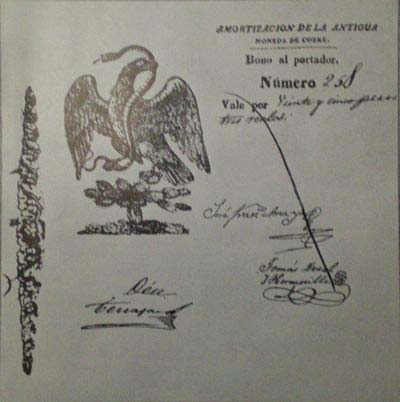
Bond 258 for $25.37 ½ , signed by José Francisco Anaya and Tomás Dozal y Hermosillo and countersigned by Terrazas (20cm x 20.5cm)
Firstly, on 20 January 1860 Governor Muñoz ordered the minting of a new issue of copper coinage and the amortisation of the existing coinage which, because of its poor quality, was easily counterfeited{footnote}Discurso of Governor Muñoz, 8 April 1860{/footnote}. The holders of the old coinage were offered bonds and by 1861 more than 100,000 pesos was owed to owners of bonds{footnote}Discurso of Governor Terrazas, 18 September 1861{/footnote}. They still appear in the accounts of the Administración General de Rentas in 1866.
| José Francisco Anaya |  |
| Tomás Dozal y Hermosillo |  |
Then, during the war against the French both President Juárez, on behalf of the government, and Governor Terrazas, on behalf of the state, authorised the minting of copper coins at the Chihuahuan mint{footnote}Periódico Oficial, 27 December 1860{/footnote}. These coins were extremely unpopular, being not accepted outside the state and with difficulty within. By 1868 they had depreciated by 70% and in May of that year the central government agreed to the use of federal receipts for their amortisation{footnote}La Republica, 7 August 1868{/footnote}. This decision caused alarm in Chihuahua and a rise in the price of bare necessities, so Terrazas suggested levying a forced loan of $100,000 to retire the remaining coins{footnote}[A ], letter of Terrazas, 28 August 1868{/footnote}.
Juan N. Zubirán went to consult with the Secretario de Hacienda in Mexico City, and on 20 August 1868 the President approved the project for amortisation. On 18 September Governor Feliciano Ruíz, in accordance with the 20 August decree, appointed Esteban Benítez president of the Junta Central de Amortizacion, composed of Domingo Leguinazábal, Juan Mandrí, José Félix Maceyra, Jorge Macmanus, Jesús Mariñelarena, Manuel de Herrera, Francisco Espinoza, Sr., and Agustín Hinojos{footnote}La República, 10 October 1868{/footnote}. As Benítez did not accept the appointment, José Félix Maceyra was named in his place and Antonio Asúnsolo added as a delegate. The junta met the next day, and apportioned the following contribution on each canton.
| Iturbide | $23,000.00 |
| Hidalgo | 22,000.00 |
| Mina | 8,000.00 |
| Rosales | 3,000.00 |
| Meoqui | 4,500.00 |
| Rayón | 3,500.00 |
| Allende | 7,000.00 |
| Guerrero | 2,500.00 |
| Bravos | 2,000.00 |
| Matamoros | 5,500.00 |
| Jimenez | 1,500.00 |
| Victoria | 3,000.00 |
| Abasolo | 2,000.00 |
| Galeana | 1,000.00 |
| Aldama | 1,000.00 |
| Camargo | 8,500.00 |
| Balleza | 2,000.00 |
| Total | $100,000.00 |
The list missed out the canton of Arteaga. On 23 September governor Ruíz asked for the reason.
On 9 October Terrazas published the provisional regulations that would effect the amortisation. The central Junta, headed by José Félix Maceyra, would issue provisional receipts and a junta of businessmen would oversee the destruction of the coins.
The government of the state of Chihuahua agreed that the certificates would be printed by the Tesorería General de la Nación in Mexico City and sent to Chihuahua. The bonds were issued in a series of six values dated 31 October 1868.
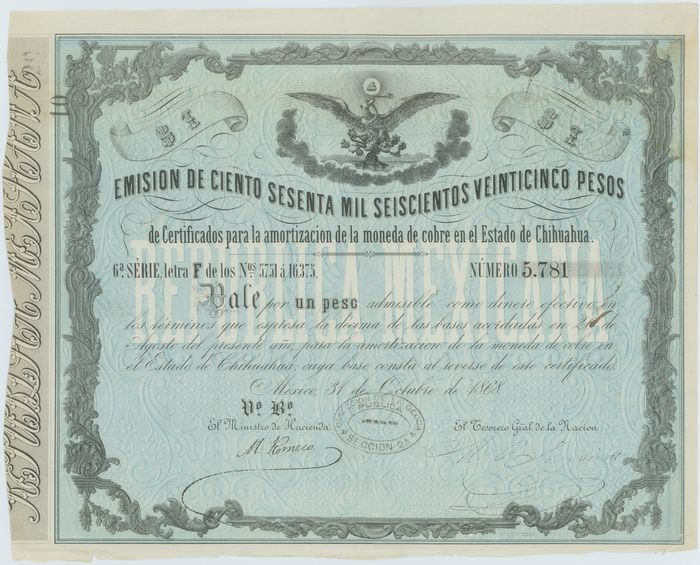
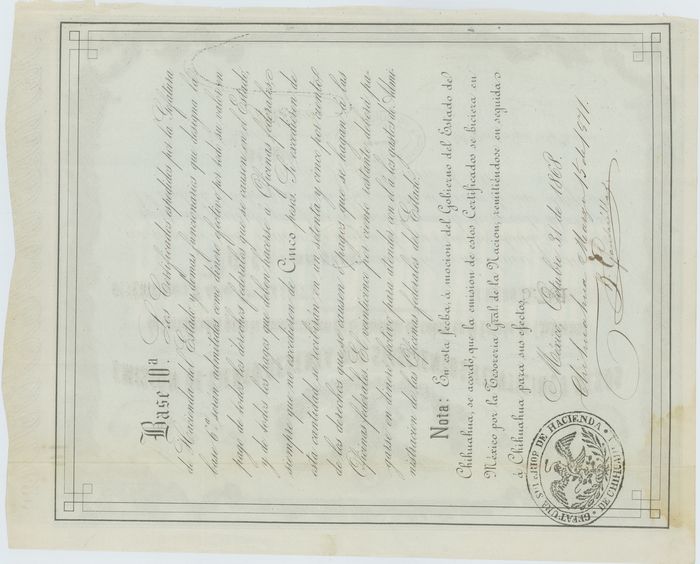
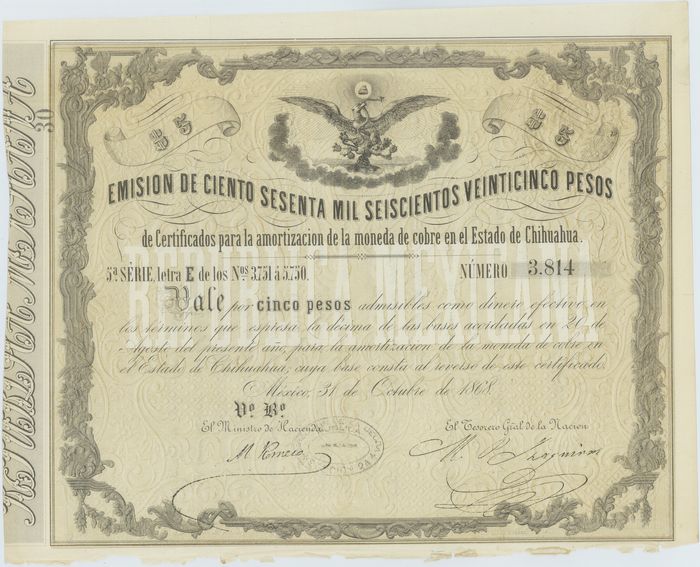
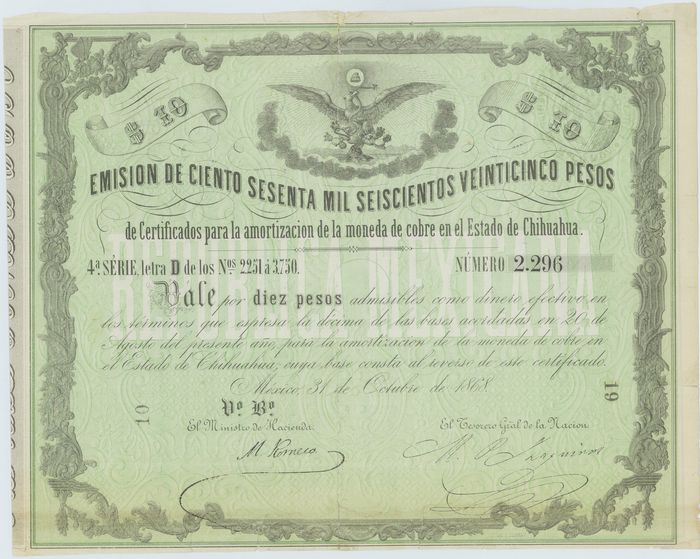
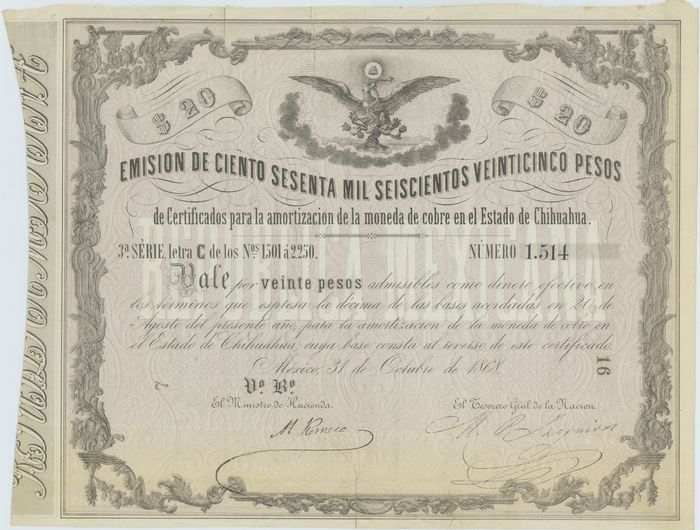
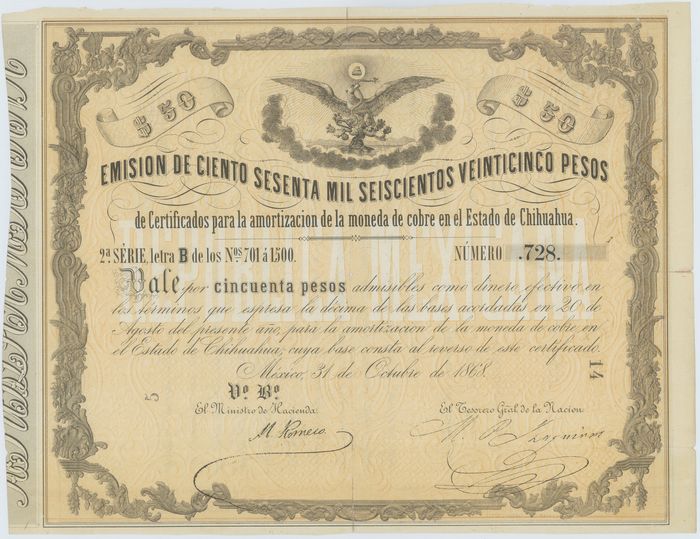
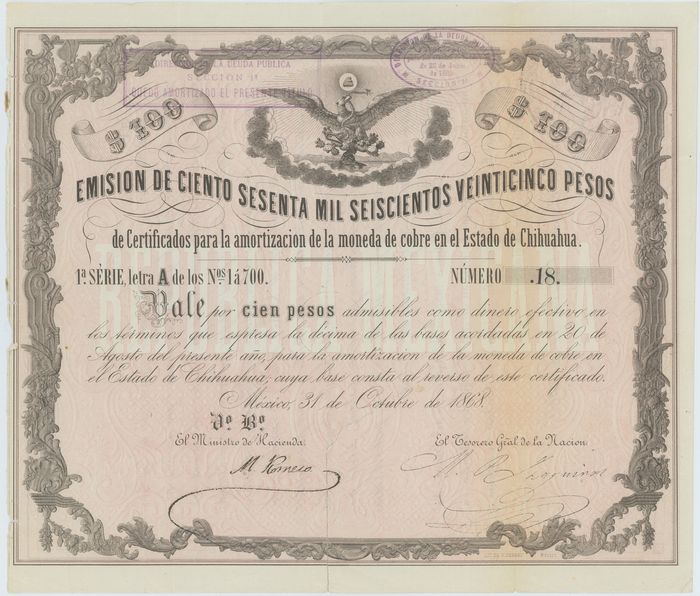
| Series | from | to | total number |
total value |
|
| $100 | 1 A | 1 | 700 | 700 | 70,000 |
| $50 | 2 B | 701 | 1500 | 800 | 40,000 |
| $20 | 3 C | 1501 | 2250 | 750 | 15.000 |
| $10 | 4 D | 2251 | 3750 | 1,500 | 15,000 |
| $5 | 5 E | 3751 | 5750 | 2,000 | 10,000 |
| $1 | 6 F | 5751 | 16375 | 10,625 | 10,625 |
| $160,625 |
They had the printed signatures of Matías Romero as Ministro de Hacienda and Manuel P. Izaguirre, as Tesorero General.
These bonds were admissible as payment for all federal duties of less than $5 or up to 75% of any duty if it exceeded that amount, the remaining quarter to be paid in hard cash. This condition (base 10a of the regulations) was printed on the reverse of the bonds.
The distribution and exchange of these bonds mainly happened in Chihuahua, even though a provision was left for some to remain in Mexico City (it is unclear if this happened or not) to help those with Chihuahua 1865-1866 cuartillas to make their exchange there. It was agreed that these bonds would be printed annually in amounts of 60,000, 40,000 and 60,000, just as the cuartillas appeared in Chihuahua. However, for different unsaid reasons, only 42,000 pesos were printed in the first batch. Very few details of this period are known. However, on 6 November 1869 an extra 15,015 pesos was approved to the usual shipment to make a quick exchange of 480,480 copper cuartillas in the hands of impatient private debters in Chihuahua who demanded their redemption in these federal bonds. Also, 42,000 pesos was said to be ready to be used in the exchange of the provisional stamps issued as temporary cash. This official notice was signed by Matías Romero.
On 7 November 1869 the Commission for the Amortisation of Copper reported and proposed that the state government act as agent for the federal government in paying the $170,000 worth of bonds that had been issued{footnote}La Republica, 19 November 1869{/footnote}.
These 1868 bonds and the immediate need for cash, the abundance of cuartillas in the state of Chihuahua and other local and regional factors compelled a crucial determinant decision. Chihuahua’s government decided to devalue all state copper coinage to half of their face value on 7 November 1870. By this sole decision the 1868 bonds were null and void, now double the number of coins would be needed to satisfy the face value of the 1868 bonds. This situation got exponentially more complex when the State Legislature of Chihuahua requested, on 31 May 1871, that the last 60,000 pesos of bonds be used as a line of credit to finish a telegraphic line from Chihuahua City to Durango City. It was a desperate attempt to salvage some of the still pending debt and avoid the cuartillas coinage all together. Later on, Chihuahua’s government tried to exit that bad deal under the premise that the telegraph system was a monopoly of the Mexican government and that Chihuahua had become the only state in the nation to pay for that monopoly. Unfortunately, the deal was done, the National Treasury did not contemplate any more money for the Treasury of Chihuahua after 1871, but rather passed this sticky situation to the Ministry of Development. This was the end of anything concrete from the two treasuries to fix that loan of Juárez of 1865. A last attempt happened in 1875 to recover any of the last 60,000 pesos in bonds, but by then the telegraph line had been finished and the bonds were worthless. The Mexican Congress did not want to revive this can of worms and it was then not a big issue for debate in the Mexican Senate. The main reason was because Juárez had been dead for three years and Matías Romero was no longer the Secretary of the Tax Revenue and Public Credit Office, but, paradoxically, Manuel P. Izaguirre, one of the co-signers of the failed 1868 bonds.
Matías Romero, now reduced to a mere witness during the 1875 debates, explained that the only legal way out for these bonds could be for them to be acquired by the Government in a future conversion of the Public Debt, if that would ever happen. And indeed it did happen eight years later. However, there was still one more breath left for these bonds to be noted before that consolidation of 1885. On 30 June 1877, the Representative of the IV Electoral District for Chihuahua, the former governor José Elijio Muñoz, signed an affidavit stating that in the Chihuahua Treasury there were 144,025 pesos in these unpayable 1868 bonds{footnote}AP papers, Box 3:1 “Historia Numismatica de Chihuahua”{/footnote}.. If this is correct, it could mean barely 16,600 pesos of these 1868 bonds in public hands. On 22 June 1885 Manuel Dublán, Secretary of the Tax Revenue and Public Credit Office, orchestrated a consolidation of Public Debt and the second section of his consolidation grouped together all official and military debts occurred by any law prior to 30 June 1882{footnote}from Ricardo de León Tallavas, "The Intriguing 1868 Chihuahua Copper Coin Bonds of Exchange" in USMexNA journal, March 2023{/footnote}.
Forced loans were frequently exacted by the state or factions within the state. It is necessary to distinguish such forced loans from extraordinary levies. The latter were just additional taxes whilst the former were nominally intended to be repaid (though many who were subject to such 'loans' did not expect to see their money again), occasionally bore interest and usually gave the lender a receipt that could be offset against future dues or taxes. Such documents, though they usually did not have printed denominations and were made out to a particular individual, were frequently transferable and, if the issuer retained or gained a position of power, of value.
The state government was already in debt by the 1860s and in his governor's statement in 1861 Terrazas reported the large claims on the state's resources included loans (not necessarily forced) made by various individuals during the recent stormy past{footnote}Discurso of Governor Terrazas, 18 September 1861{/footnote}. However, the period of the French intervention and the various revolts in the 1870s were particularly fertile times. The following list is no doubt not exhaustive.
During the French intervention Terrazas levied forced loans of $40,000 on 18 May 1862{footnote}La Alianza de la Frontera, 22 May 1862. The sum was to be divided between the districts thus:
Iturbide $8,000
Hidalgo 6,600
Mina 2,000
Rosales 1,800
Rayón 1,600
Allende 2,000
Guerrero 2,000
Bravos 2,000
Matamoros 2,000
Jimenéz 1,000
Victoria 2,500
Abasolo 1,600
Balleza 2,000
Camargo 2,500
Galeana 1,200
Aldama 1,200{/footnote}, $21,000 on 3 September 1862{footnote}La Alianza de la Frontera, 4 September 1862. The sum was to be divided between the districts thus:
Iturbide $4,000
Hidalgo 3,600
Mina 1,000
Rosales 1,000
Rayón 800
Allende 1,100
Guerrero 1,100
Bravos 1,000
Matamoros 1,100
Jimenéz 600
Victoria 1,200
Abasolo 800
Balleza 1,000
Camargo 1,500
Galeana 600
Aldama 600{/footnote}, $33,000 on 16 May 1863{footnote}La Alianza de la Frontera, 16 May 1863. The division was:
Iturbide $7,200.00
Hidalgo 7,200.00
Mina 2,400.00 (Guadalupe y Calvo 1,500, Morelos 800, Batopilas 100)
Rosales 2,400.00
Rayón 800.00
Allende 2,100.00
Guerrero 1,300.00
Bravos 1,000.00
Matamoros 1,000.00
Jiménez 600.00
Victoria 800.00
Abasolo 700.00
Galeana 600.00
Aldama 500.00
Camargo 4,000.00
Balleza 600.00{/footnote} and $99,000 on 25 June 1863{footnote}La Alianza de la Frontera, 25 June 1863. Including $7,200 from Mina but with a rebate of $4,500 (Guadalupe y Calvo $2,814; Morelos $1,500, Batopilas $186){/footnote}.
Angel Trias levied a forced loan of $10,000 on seventeen private citizens in the capital (including Luis Terrazas, Mariano Sáenz, Félix Maceyra and Antonio Asúnsolo) in October 1864. The loan was to have been repaid within three months{footnote}El Republicano, 29 October 1864. The full list was:
José Cordero $3,000
Viuda de Olivares $1,600
Luis Terrazas $1,000
Mariano Saenz $1,500
Félix Maceyra $350
Antonio Asúnsolo $250
Juan M. Asúnsolo $100
Avila y Jurada $400
Leonardo Siqueiros $100
Salido y Puchi $500
Juan Mandri $500
Rafael Gameros $300
Joaquin Campa $100
Faudoa y Zabiata $50
Berardo Rivilla $100
Mariano Maceyra $50
Miguel Betancourt $100{/footnote}. Angel Trias also imposed a contribution of 100,000 pesos on the state{footnote}ibid.{/footnote}. There survives a receipt from Parral dated 11 December 1864 and signed by Z. Villanueva.
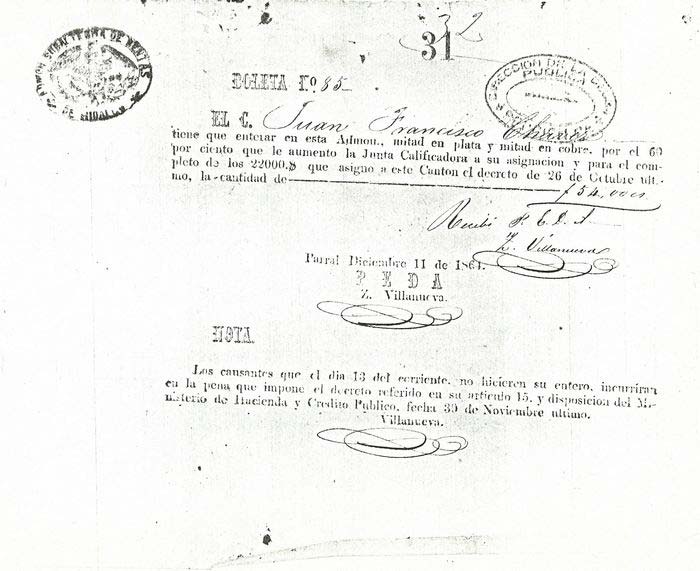
The receipt is a demand, numbered 'Boleta No. 85', stating that the person named has to hand over to the Administrador de Rentas, half in silver and half in copper, his share of the $22,000 levied on the canton by the Junta Calificadora by the decree of 26 October[text needed], with a hand-written acknowledgement of receipt.{/footnote}.
There was a forced loan by the Junta Calificadora (Assessment Board) in Guadalupe y Calvo on 7 March 1865{footnote}Francisco Almada, Guadalupe y Calvo, Mexico, 1940{/footnote}.
On 9 September 1865 General Remedios Meza, with the 2a Brigada de Durango asked for a forced loan (prestamo extraordinario) of $15,000 from Guadalupe y Calvo, which the Jefe Político managed to get reduced to $9,000. They handed over $2,500 from federal funds, and $2,000 from the decree of 7 June, with the rest distributed amongst the businesses and inhabitants of Guadalupe y Calvo, with the condition that the State of Durango would repay it. However, when the holders of the documents issued by Meza later sought reimbursement they were unsuccessful{footnote}ibid.{/footnote}.
On 18 June 1871 the rebels Francisco Cañedo, Doroteo López and Adolfo Begne captured Guadalupe y Calvo and imposed a forced loan of ten thousand pesos. They retreated to Sinaloa a week later.
In July 1872 the Porfirista Donato Guerra captured Chihuahua City and imposed a forced loan of 150,000 pesos. Governor Terrazas had retreated to Guerrero, from where he sent Gabriel Casavantes and José Valenzuela out to the Sierre Madre mining districts with instructions to raise loans for the cost of resistance under the nominal guarantee of the State Treasury. The next month, when Guerra reached a peace agreement with Terrazas, it was decided to hand the matter of Guerra's loan over to the federal authority in Mexico City to decide how to resolve the affair.
In 1876, when President Sebastian Lerdo announced that he was to seek re-election, the disappointed Porfirio Díaz again rose in revolt. In Chihuahua Angel Trias declared for Díaz, besieged the state capital and took Governor Ochoa prisoner. The Tuxtepecanos held Chihuahua City from 2 June to 19 September. In July Trias, as Military Commander, levied a forced loan of $56,000 on the principal citizens and issued certificados, which were to be accepted for tax purposes by state and federal offices{footnote}Boletin Militar, 1 July 1876. The list was:
Nestor Armijo $2,500
Antonio Asunsolo 2,000
Henrique Muller 2,000
José de la Luz Corral 2,000
Luis Faudoa 2,000
Ketelsen y Degetau 2,000
Francisco Macmanus 2,000
Félix Francisco Maceyra 2,000
Enrique Norwald 2,000
González Treviño Hermanos 2,000
Luis Terrazas 2,000
Nicolás Armijo 1,500
Banco de Chihuahua 1,500
Gosch y Markt 1,500
Guillermo Hagelsieb 1,500
Pedro Zuloaga 1,500
Ramón Luján (for self and Senora Dolores Alvarez) 1,500
Walterio Henry 1,500
Miguel Betancourt 1,000
Agustín Cordero Zuza 1,000
Domingo Leguinazábal 1,000
José Félix Maceyra 1,000
Horcasitas Hermanos 1,000
Gustavo Moye 1,000
Mariano Puchi 1,000
Casa de Mariano Sáenz 1,000
Miguel Salas 1,000
Jesús María Ortiz 800
Viuda de Chabre e hijos 800
Juan Manuel Asúnsolo 600
Grandfan y Audetal 600
Eduardo Fricth 500
Fuentes y Bezaury 500
Testamentaría de D. Francisco Celis 500
Compañía Americana 500
Carlos Moya 500
Francisco Mollmaun 500
Testamentaría de Mariano Maceyra 500
Dr. Jesús Muñoz 500
Treviño y Tejeda 500
Pedro Mignagoren 500
Lic. Antonio Jáquez 400
Guillermo Moye 400
Miguel San Martín 400
Dionisio Trías 400
José María Sini 350
Ignacio Uranga 300
Genaro Chavéz 300
Bermúdez Hermanos 300
Testamentaría de Da. Jesús Porras de González 300
Luciano Delgado 250
Viuda de Bustamante e hijo 250
Viuda de Felipe Siqueiros 200
Da. Concepción Gabaldón 200
Francisco Marquéz 200
Eduardo Ptacnick 150
Concepción Orcillo 100
Juan Chavéz 100
Da. Concepción Maceyra 100
Pedro Olivares 100
Miguel Sepúlveda 100
Doña Josefa Terrazas 100
Lorenzo Martín del Campo 100
Bartolo Guereque 50{/footnote}. Terrazas was upset by his own assessment of $2,000, slipped away to his haciendas and began to organise the resistance.
Enrique Müller also refused to pay the 3,500 pesos{footnote}presumably the $2,000 in his own name and the $1,500 levied on the Banco de Chihuahua{/footnote}assessed in Trias' levy, escaped to the countryside and from his hiding place aided the loyal troops. It was Müller’s misfortune to fall into the hands of a band of rebels commanded by Colonel Delgado who took his prisoners to El Paso del Norte (now Ciudad Juárez). Müller sought the protection of the American military commander at El Paso and the latter threatened to bombard the Mexican town unless Müller was released, which by the way was not done though fortunately the threat went unfulfilled{footnote}Mrs. Müller through some friends applied to Colonel Andrews at Ft. Davis, who responded by (SD papers, letter Louis H.Scott to , 25 January 1877. Scott had not yet received his Exequatur and so was not formally recognized as the U.S. consul in Chihuahua){/footnote}. The New York Herald, however, published an article by John Watson Foster, then United States Minister to Mexico, relative to the Müller case with the alarming headlines, “The Turks of America. Mexico and its Abuses upon American Citizens. A Government of Thieves.”
When Müller was arrested, he was in company with four other gentlemen, all of whom claimed to be citizens of the German Empire. These four German citizens were held for a few days and then allowed to leave, leaving only a portion of their arms and a small sum of money which they happened to have on their persons. Müller, however, was kept a close prisoner for more than a month, dragged over rough mountains and across a desert country, placed in their first ranks under the fire of his friends, and obliged to submit to every iniquity which they could possibly offer to him. They even stole his saddle and his boots, and then after treating him in this manner, exacted $3,500 for his ransom. When the kidnapping was reported to Mexico City, Díaz sent a message cautioning the commanding general against further outrages against Germans, but did not mention Americans.
When Müller was released after paying the ransom, the first thing the state government did was to demand a ‘loan’ of $4,000, which Müller did not expect to be repaid.
The United States government, through its diplomatic channels, investigated the Müller affair and the Mexican authorities were exonerated by the Hon. J. C. Houston, American Vice-Consul in Chihuahua City, on 3 August 1877{footnote}Memorias de Hacienda 1878-1879, México, 1880{/footnote}.
During the Tuxtepecano occupation Americans were forced to pay many thousand dollars in money, and a refusal to pay was followed by immediate imprisonment{footnote}SD papers, letter Louis H. Scott to Hamilton Fish, Mexico, 23 January 1877. The Department of State received the letter on 10 February 1877 and acknowledged it on 13 July. Scott was to inform the Department of all such proceedings and take the depositions of the sufferers for future use {/footnote}. Acting governor Samaniego surrendered Chihuahua City to the Porfirista General Juan B. Caamaño on 5 February 1876. Later that same day General Angel Trias and his forces entered the city. Apparently there was some disagreement between the two generals and Trias soon tendered his resignation to Caamaño and retired to private life. Caamaño needed money for his troops, and learning that there was a lot of merchandise lying at Presidio del Norte, told the merchants, the Treviño Bros, Gustavo Moye, Henry Nordwald and Francisco Macmanus and Sons, that if they introduced their goods and paid him the duties, he would not have to resort to a forced loan. He stated that he would send an escort of two hundred men and bring in the (wagon) train and have them passed by the Custom House officer in Chihuahua, as there was no organized Custom House force in Presidio at the time. The merchants agreed and paid {footnote}about $30,000,according to Scott in his report of or $10,000 from Nordwald and Macmanus, according to his letter of 9 July 1877{/footnote}, the money was used to pay off some of Caamaño’s troops, and the train started for Chihuahua on 19 February. They had journeyed one or two days when Trias arrived and ordered the train back to Presidio. Trias demanded that the goods were passed through the Presidio Custom House before proceeding to Chihuahua, and that the owners hand over $6,000 as part payment of the duties to be paid.
At the time they paid Caamaño the merchants believed he had the authority of the Díaz government, but on 14 February Jose Eligio Muñoz arrived in Chihuahua as provisional governor and one of his first statements was to the effect that he would not recognize the transactions made by Caamaño and that he would compel the merchants to pay the duties a second time. Caamaño under these circumstances would not hand over the government to Muñoz and Trias, who, finding themselves foiled, took possession of the train and demanded that the merchants pay the duties again{footnote}SD papers, letter H. Nordwald and F. Macmanus and Sons to John W. Foster, 5 March 877{/footnote}. The merchants demurred and asked for the matter to be placed before the parties in Mexico City and said that they would abide by the decision whatever that might be. This was refused so after some parlay F. Macmanus and Sons gave Trias $2,000 (and the duties which were about $3,000) and H. Nordwald gave him $4, 000 (and his duties which were nearly $8,000){footnote}SD papers, letter H. Nordwald and F. Macmanus and Sons to John W. Foster, 5 March 1877; letter Scott to W. Houston, Secretary to Assistant Secretary of State, Washington, 10 April 1877{/footnote}.
Trias held the city from 2 June until 19 September, when it was again occupied by the opposition.
The two American companies asked for the Díaz’ government to recognise the payment and renew business confidence{footnote}SD papers, letter H. Nordwald and F. Macmanus and Sons to John W. Foster, 5 March 877{/footnote}. On 8 March 1877 the U.S. consul, Louis H. Scott, also wrote to Foster, embellishing on the characters of Trias and Muñoz{footnote}SD papers, letter Louis H. Scott to John W. Foster, 8 March 877{/footnote}.Gustavo Moye sent a similar petition through the German Consul to their Minister{footnote}SD papers, letter H. Nordwald and F. Macmanus and Sons to John W. Foster, 5 March 877. Trias was “a man entirely “given over to cups.” After his defeat at the “Avalos” on the 19th of Sept. he went to San Antonio Texas, where he carried on his drunken frolics as long as his ill gotten money lasted. He was arrested and fined in the police courts at San Antonio as a common drunkard. When the news of Gen. Diaz’ success became known, Trias returned to Mexico and gathered around him a few of his desperate followers. He and his party came with Gen. Caamaño, and when Gov. Samaniego went out to treat with Gen. Caamaño, a messenger was dispatched to Trias’ camp near by, inviting him to be present at the council. Unfortunately he was too drunk to do so. The following morning when Gen. Caamaño occupied the “Plaza” Trias was so drunk that four men could not place him in his saddle, so the people say who saw him. It was until late in the afternoon of the same day that he could be made presentable.
Now for our worthy Gov. He was refused his seat in the Congress of Mexico as an evil minded man, one who poisoned everything with which he came in contact, and he is generally known here as the “Bird of Prey.” He is of all men that Gen. Diaz could select, the most unpopular, and a more revengeful and vindictive man I know can not be found. He takes affront where none is intended, but it serves his purpose as well and he wrecks his vengeance all the same. Muñoz and Trias would in one short year ruin this state beyond redemption. What can the people of Chihuahua look forward to with a Governor whose chief delight is to bring trouble and disaster upon commerce, who dislikes all foreigners with a deadly hatred, and whose chief ally and supporter is a drunken worthless man who is under the influence of the most desperate class of men the State can produce”.{/footnote}
On 21 March Scott wrote to the State Department, explaining the critical situation of the Americans residing in Chihuahua, and stating that German citizens were protected while Americans were not. Scott asked for instructions on how to act and what protection the treaty between the USA and Mexico gave to Americans residing in Mexico{footnote}SD papers, letter Scott to State Department, Washington, 21 March 1877{/footnote}.
The day before Naranjo’s arrival in Chihuahua governor Muñoz and General Trias sent an armed force to the offices of H. Nordwald and Francisco Macmanus and Sons demanding from each firm $5,000 or the embargo of their safes. Macmanus and Sons’ duties were a trifle less than $4,000. As they had already paid Caamaño more than the duties amounted to and had given to Trias, with Muñoz’ consent, over $2,000 on the duties they were now exacting for the second time, both replied “take our safes, imprison us, but pay you this amount, we will not, under any consideration whatever.” The troops invaded the private office of Mr. Nordwald and occupied it, but they did not come any further than the door of Macmanus & Sons. Nordwald had also paid Trias a portion of duties before they made a demand on him for the $5,000. The merchants held out, and the next day Naranjo arrived and settled the business by making a new loan to which both merchants paid $2,000 each.
The next day, General Naranjo at the head of fifteen hundred men marched into Chihuahua and remained for thirty days. In order to support his troops he compelled F. Macmanus and Sons to pay him $2,600, for which he gave them an order on the Customs Houses at either Presidio del Norte or El Paso for the amount so paid adding to the order $2,500 which had been paid to General Trias when he occupied Chihuahua during the months of June and July 1876, in return for their receipts. This new order was given by General Naranjo and approved by Governor Muñoz and the chief of the Custom Houses of the state (or State Treasurer). However, later, the Custom House official at Presidio del Norte, Juan Muñoz (a brother of the former governor) informed Macmanus’ agent at Presidio that he had instructions from Mexico City of Mexico not to pass any goods upon the orders of Naranjo. Although he passed goods for Mexican on just such an order, he told Macmanus that he would exact the greater part of any duties in money and accept the orders only for the smaller part. Macmanus and Sons asked for the American Minister in Mexico City o get the orders recognized{footnote}SD papers, letter Louis H. Scott to F. H. Seward, Assistant Secretary of State, 9 July 1877{/footnote}.
Naranjo then astounded Macmanus and Sons by saying that he would not recognize the amount paid to Trias on the duties as he did not know what Trias had done with the money. However, he did not succeed however in making them pay more than $540 for the third time{footnote}SD papers, letter Louis H. Scott to F. H. Seward, Assistant Secretary of State, 9 July 1877{/footnote}.
Francisco Macmanus once refused payment of a so-called loan of $4,000.Twenty soldiers with fixed bayonets were placed in his store and an officer with drawn sword demanded the money or the result would be worse with him. Macmanus had a notary at his counter and submitted a written protest, but that did not save him from paying the money. He sent the claim to Mexico City but his attorney advised him not to spend any more money over the matter as it was utterly hopeless and he would never recover a cent{footnote}{/footnote}.
On 4 April Foster met Sr. Vallarte, the Minister of Foreign Affairs, to remonstrate against the exaction of the forced loans. Vallarta sent orders to Chihuahua to desist from forced loans against Americans, and since then American citizens had not been molested. Francisco Macmanus had stated that he with other merchants were requested by Governor Muñoz and General Trias to make some “advance” to them “to pay off their troops, but all these sums had been repaid or adjusted by orders of the Customhouses, which the merchants have accepted; and that the only unsettled claims of American citizens were the loans to Caamaño.
As for the Müller affair, Foster reported to the American Secretary of State that, following the reports in American newspapers, as soon as he had any authentic facts, he brought the matter to the Mexican government’s attention, but of course this was long after Müller had paid the money and been released. Müller had never made a statement of his complaint to Foster or to the consul at Chihuahua, so Foster had no data upon which to make a formal complaint or demand; but he had notified the Minister of Foreign Affairs that in due course he would present a formal complaint and expect full reparation for all damages and injuries to Mr. Müller. The explanation of the release of Mr. Müller’s German companions, at the time of his seizure, as given to Foster, was that the Trias partisans had two causes of ill-will towards Müller personally: firstly, had refused and evaded the payment of a $3,500 forced loan levied by Trias in Chihuahua some months before and secondly, he had participated in the defence of his hacienda, when attacked by a party of Trias guerrillas when a number of the latter had lost their lives. The question of nationality did not enter into the matter so much as the spirit of revenge.
Foster also suggested that it was an opportune time to insist upon the addition of an article to the Treaty of 1831, specifically exempting American residents and property from forced loans{SD papers, letter Foster to William H. Seward, Secretary of State, 26 May 1877{/footnote}.
When Terrazas recaptured the capital his party also resorted to forced loans to pay for the costs of the war since we have a record of a receipt (Billete númo 56) for $1,000 issued to José Dolores Solís. This short-term loan (prestamo de pronto reintegro), which had yet to be repaid three years later, was to cover the expenses of the Jefatura de Hacienda and could be used to pay federal taxes (para cubrir las atenciones de ésta Gefatura de Hacienda ... los cuales ... serán devueltos con los derechos federales que cause próximamente, admitiéndosele en págo de los mismos){footnote}details from Clyde Hubbard{/footnote}.
On 12 December 1876 the Porfirista Emiliano Ibarra entered Chinípas and imposed loans on the inhabitants. However, he was attacked four days later by the Comandante Militar Jesús Marquez, Ignacio Rascon and a troop of irregulars and driven back to Sinaloa.
On 18 January 1877 the Porfirista Estanislao González Porras, as Coronel en Jefe de la Brigada de Operaciones and Comandante Militar del Estado, decreed a forced loan of fifteen thousand pesos on the town of Hidalgo del Parral. The loan was to be repaid 'conscientiously and completely' (con toda conciencia y exactitud) as soon as the Porfiristas captured the state capital. Ten days later Porras collected another fifteen thousand pesos{footnote}Almada, Resumen de historia del Estado de Chihuahua, Mexico, 1955, has the text of a decree dated 18 January 1877 and of another in similar words dated 28 January 1877. These might refer to the same 15,000 pesos though both demand immediate payment. Almada also has the text of a receipt: 'PRESTAMO FORZOSO. - El Sr. Dn. Luis G. Hevia, ha enterado a la Recaudación de Rentas de esta Ciudad, la cantidad de SEISCIENTOS PESOS FUERTES ($600·00) que le fueron asignados por la Comandancia Militar. - Hidalgo, Enero 28 de 1877'{/footnote}.
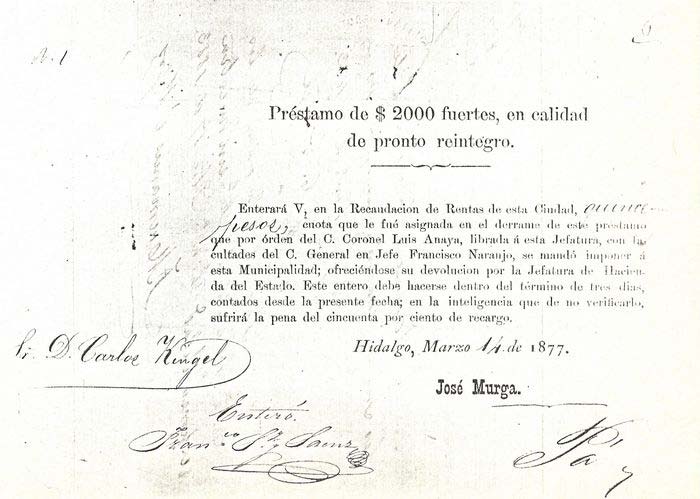
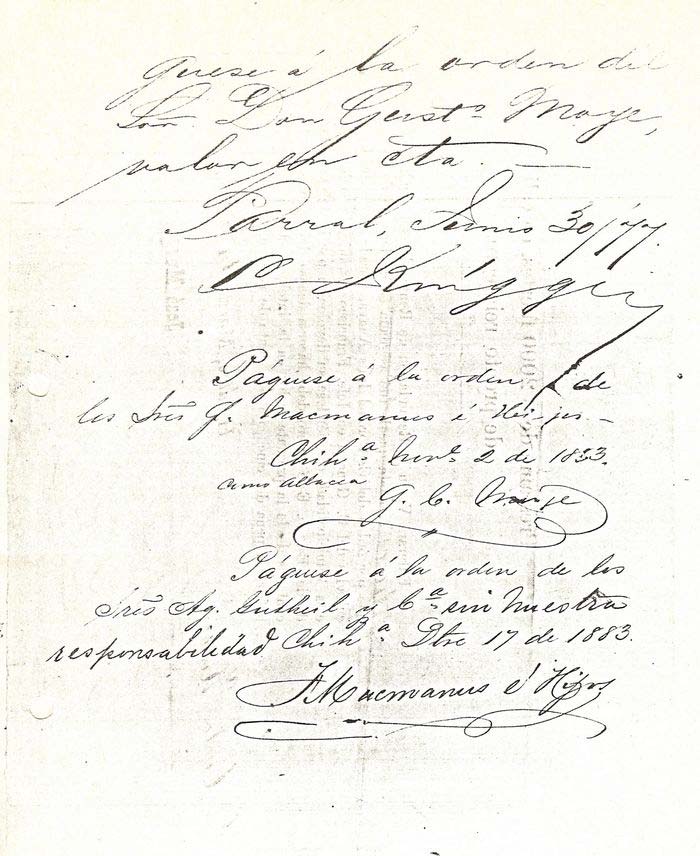
Later Colonel Luis Anaya, using powers granted by General en Jefe Francisco Naranjo, levied another forced loan of $2,000 (Prestamo de $ 2000 fuertes, en calidad de pronto reintegro) on Parral. We know of one receipt for fifteen pesos dated 14 March and signed by José Murga. This was endorsed on three separate occasions, passing at one stage through the hand of Francisco Macmanus y Hijos (the Banco de Santa Eulalia){footnote}It was transferred to Gustavo Moye on 30 June 1877; to MacManus and Sons on 2 June 1883 and to Ag. Gulhul y Ca. on 17 September 1883 (details from Clyde Hubbard){/footnote}.
In April 1877 Naranjo negotiated a loan of $10,000 at 12% interest with some of the main businessmen in Ciudad Chihuahua. He should have obtained the authorization of the Federal government because payment was guaranteed with the contributions that the Chihuahua mint would pay{footnote}AP papers, Box 3:1 “Historia Numismatica de Chihuahua”{/footnote}.
On 26 August 1879 there was an uprising in Guerrero, allegedly because of a forced loan (contribución extraordinaria) decreed by the local legislature to pay for the war against the Apaches{footnote}Almada, Gobernadores de Chihuahua, 1950, p 369{/footnote}.
Politics in Chihuahua became less violent with the victory of Díaz and, later in 1884, the completion of the Central Mexican Railroad, which not only connected the state with the rest of the Republic but also allowed the federal authorities quickly to dispatch troops. In May 1877 Governor José Eligio Muñoz commissioned the Secretaría del Gobierno to establish the size of the debt arising from the costs of the recent rebellion (excluding the créditos of the defeated administration). Once this was determined, Congress would decide how to amortise the debt{footnote}El Guardia Nacional, 10 May 1877{/footnote}.
People who had lent money or provided goods to the victorious regime presumably had receipts but as a receipt was not a negotiable instrument their investment was effectively frozen. It was therefore resolved to issue certificados in accordance with the receipts that were presented and confirmed. This on the one hand permitted the government to convert the debts and on the other gave to the creditors an official document that could be negotiable.
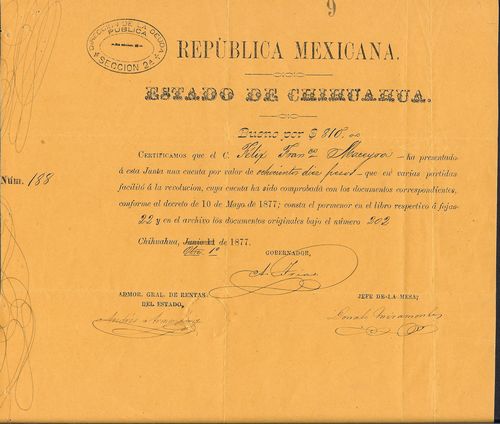
Such certificados carried the printed date 11 June 1877 (frequently amended by hand) and were signed by the Governor (Pedro Hinojosa or Angel Trias), Administrador General de Rentas (M. G. Vidal or Andrés Armendáriz) and Jefe de la Mesa (Vicente Ochoa or Donato Miramontes){footnote}The text of such certificados was 'Republica Mexicana/Estado de Chihuahua/Bueno por .../Certificamos que el C .... ha presentado á esta junta una cuenta por valor de ... en varias partidas facilitó á la revolución, cuya cuenta ha sido comprabada con los documentos correspondientes, conforme al decreto de 10 de mayo de 1877...' One certificado (Num. 98) was transferred to different parties seven times between July 1877 and January 1895{/footnote}.
A short time after Angel Trias became governor in 1877 he made the Tesorería General del Estado establish the amount that was owed to creditors of the public treasury, mostly unpaid wages of civil servants and employees. The public debt was consolidated at $242,631·67 and titulos issued to creditors. In November 1877 Lauro Carrillo was allowing such bonos o créditos reconocidos to be used in payment of taxes{footnote}El Estado de Chihuahua, 12 November 1877{/footnote}.
In June 1889 Governor Carrillo set up a special section within the Tesorería General del Estado again to consolidate the outstanding debts. Creditors and holders of créditos had six months within which to present their claims and the section was given another four months thereafter to consider their validity. Then the Tesorería General would issue bonds (bonos al portador), such bonds to be in denominations of 10, 100, 500 and 1000 pesos, signed by the Governor, Tesorero and Contador, progressively numbered and recorded in a book kept in the Tesorería{footnote}El Estado de Chihuahua, 29 June 1889{/footnote}.
In July 1890 the public debt was verified to be $218,193·71{footnote}El Estado de Chihuahua, 9 August 1890{/footnote}. The bonds had been printed by the American Bank Note Company in 1889{footnote}American Bank Note Company specimens are dated 16 October 1889{/footnote}.


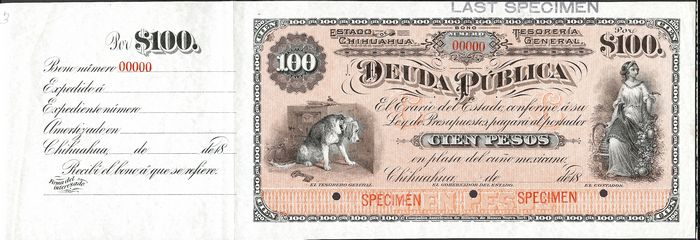
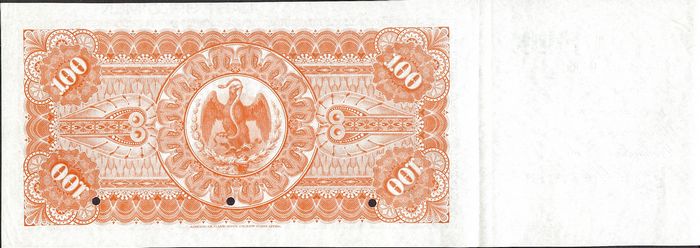

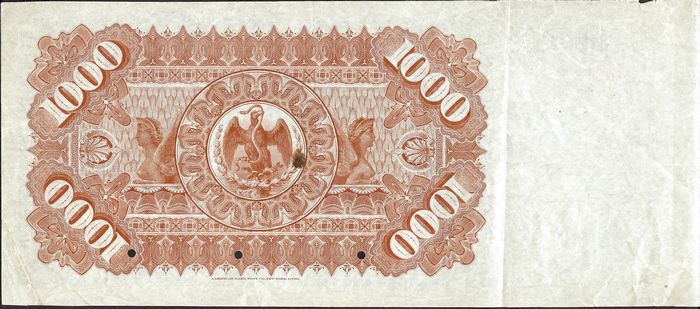
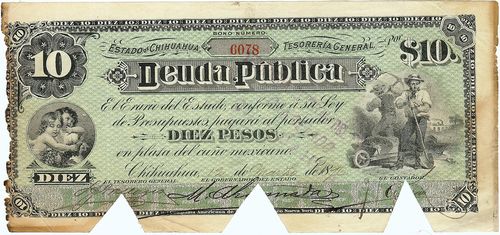
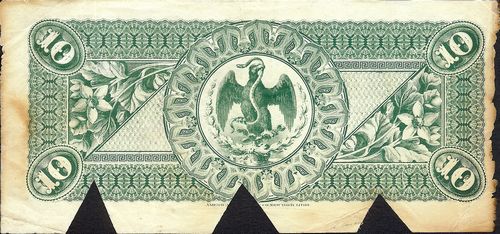
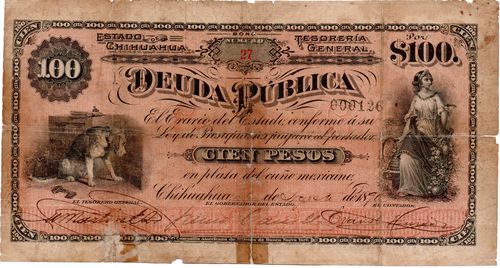

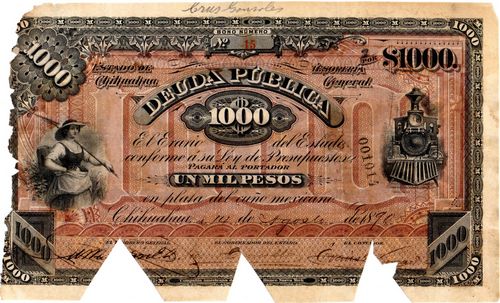
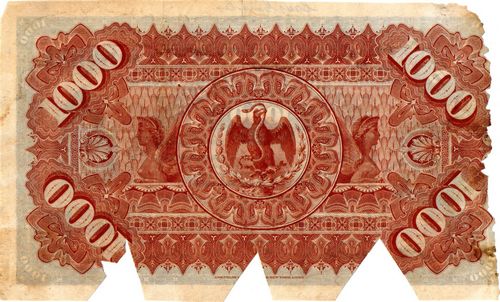
At least $193,270 were issued. The Periódicos Oficiales list 26 holders with a total of $66,600 on 6 September 1890, 25 holders with $72,390 on 1 October 1890 and 16 holders with $50,290 on 8 November 1890. Later two decrees (4 December 1891 and 17 December 1891) added a further $4,590. According to the individual sums and assuming the minimum number of bonds the number of bonds issued will have been
| $10 | $100 | $500 | $1000 | |
| 6 September 1890 | 110 | 60 | 11 | 54 |
| 1 October 1890 | 79 | 36 | 12 | 62 |
| 8 November 1890 | 69 | 36 | 4 | 44 |
| 4 December 1891 | 3 | 6 | 1 | 1 |
| 17 December 1891 | 6 | 4 | 2 | |
| 267 | 142 | 28 | 163 |
$18,240 in bonds were redeemed in September and October 1892. However, claims against the Tesorería continued to mount and in December 1894 under Governor Miguel Ahumada the whole process was repeated, though claims that had previously been rejected were excluded. This time the state was to issue bonds with the value of 10, 50 and 100 pesos{footnote}El Estado de Chihuahua, 28 December 1894{/footnote}. A year later the Congress acknowledged the outstanding debt to be $50,143·43 and issued bonos to forty-two creditors{footnote}Periódico Oficial, 1909{/footnote} though later on it added Gaspar Horcasitas' claim for $2,385·75 and there might have been others.
The signatories were:
| Lorenzo J. Arellano Milán: born in Mazatlán in 1860 and moved as a child to Urique. He moved to Chihuahua in 1882, was a deputy in various local legislatures and Tesorero General del Estado from 3 January 1893 to 1 June 1903. He later served as jefe político of Iturbide in 1911, Presidente Municipal of Chihuahua in 1913, and later Subtesorero General of the Federal District until his death in 1926. | |
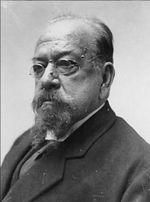 Miguel Ahumada: Born in 1844 in Colima, Ahumada was in charge of the tax service (Jefe de la Gendarmería Fiscal) in Chihuahua in 1892 when Díaz chose him as the compromise candidate for the governorship to settle the political infighting between the Terrazas and Carrillo cliques. He was governor from 1892 until 1904 though he renounced the post in 1903 when he was elected governor of Jalisco. Later, during the Maderista revolt in 1911, Díaz once again called upon him to take over the governorship but this time his influence and prestige were unable to deflect the revolution and he handed over the reins to Abraham González on 10 June. He died on 27 August 1916. Miguel Ahumada: Born in 1844 in Colima, Ahumada was in charge of the tax service (Jefe de la Gendarmería Fiscal) in Chihuahua in 1892 when Díaz chose him as the compromise candidate for the governorship to settle the political infighting between the Terrazas and Carrillo cliques. He was governor from 1892 until 1904 though he renounced the post in 1903 when he was elected governor of Jalisco. Later, during the Maderista revolt in 1911, Díaz once again called upon him to take over the governorship but this time his influence and prestige were unable to deflect the revolution and he handed over the reins to Abraham González on 10 June. He died on 27 August 1916. |
On 14 March 1908 the Tesorero General, J. Lamelas, told holders of outstanding bonds issued in accordance with the decrees of 31 July 1890 and 14 December 1895 to present them for immediate payment, as they would be declared null and void as soon as the time was right{footnote}Periódico Oficial, 15 March 1908{/footnote}.They had been all but redeemed by 1909, when only $2,780 was outstanding{footnote}Informe of Governor Enrique Creel, 1 June 1909{/footnote}.
On 8 February 1898 Governor Ahumada decreed the issue of six hundred bonds of $1,000 each to subsidize the construction of the Chihuahua al Pacifico railway. The bonds offered 5% interest and were to be redeemed in twenty-five years.
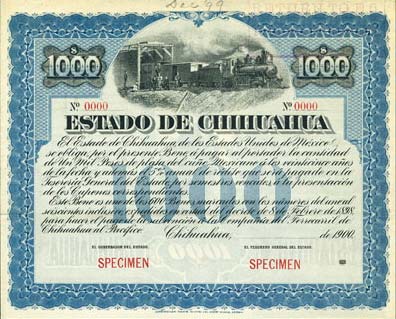
On 31 July 1899 the governor authorised a similar issue for the Central Mexicano railway for the line between Parral and the Chihuahua-Durango border.
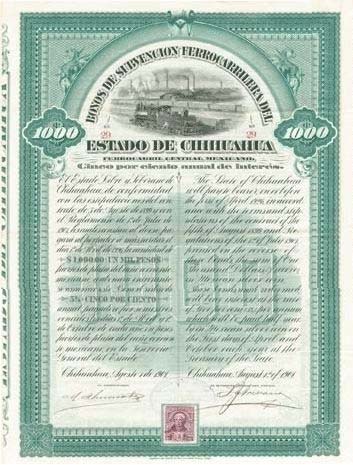
On 14 November 1904 Governor Enrique C. Creel issued regulations on redeeming these bonds, which had reached the sum of $685,000. They were to be redeemed twice yearly by lot: redeemed bonds were to be perforated ‘Cancelado’ and destroyed after ten years.
In his Informe of 16 September 1911 Governor González reported that $6,000 in bonos ferrocarrlieros had been amortised since 1 June 1911 and that $487,000 was outstanding in the Subvención al Ferrocarril de Chihuahua al Pacifico and $63,000 in the Subvención al Ferrocarril Central Mexicano{footnote}Informe of González, 16 September 1911{/footnote}.
We known of one issued $1,000 bond, numbered 545, dated 1 July 1900 and signed by Miguel Ahumada as Governor and Lorenzo Arellano as Tesorero General, whilst a 1913 reference mentions $100 Chihuahua al Pacifico and $100 Central Mexicano bonds.
On 15 June 1907 Governor José Maria Sánchez authorised an issue of $55,000 in bonds to finance local government (la deuda de los Municipios del Estado){footnote}Periódico Oficial, 20 June 1907{/footnote}. In his Informe of 16 September 1911 Governor González reported that $740 in bonos municipales had been amortised since 1 June 1911 and that $32,970 was still outstanding{footnote}Informe of González, 16 September 1911{/footnote}. On 1 July 1913 Lorenzo J. Arellano, Presidente Municipal Interino of Chihuahua, reported that to date the debts of the municipios amounted to $58,437.17, for which $55,530 had been issued in bonos, in the form of 490 $10 bonds, 511 $50 bonds and 250 $100 bonds{footnote}Periódico Oficial, 6 July 1913{/footnote}.
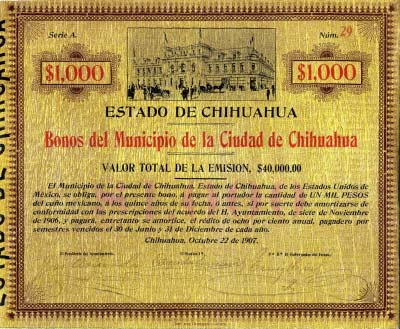
In 1907 the city of Chihuhua raised $40,000 to build an abattoir through a bond issue of 40 bonds of $1,000 each, payable 'al portador'. The bonds offered 8% interest and were to be redeemed in fifteen years, unless previously redeemed by lot. Seven of these were redeemed in six-monthly lots before the revolution{footnote} AMC, Fondo Revolución, Sección Presidencia, Año 1910, caja 2, expediente 46; Año 1911, caja 3, expediente 10{/footnote}:
| Date | Number |
| 31 December 1908 | 1 |
| 37 | |
| 1 July 1909 | 27 |
| 4 January 1910 | 28 |
| 30 June 1910 | 25 |
| 2 January 1911 | 26 |
| 31 June 1911 |
whilst number 11 was redeemed by the Banco Minero on 27 December 1912{footnote}AC, Hacienda, 1913, though it is described as a $100 bond (Empréstito del Rastro){/footnote}.
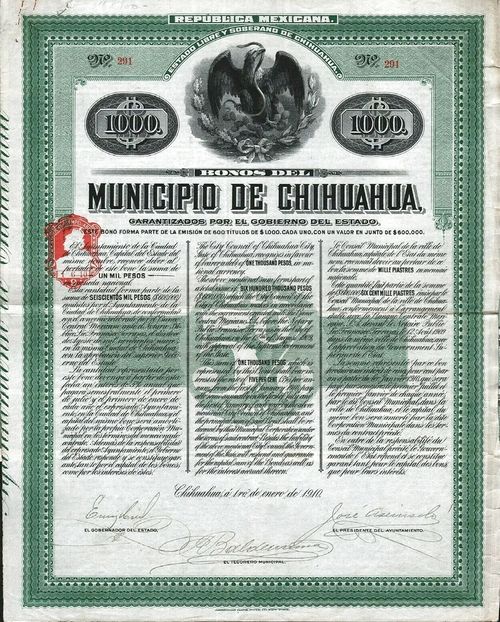
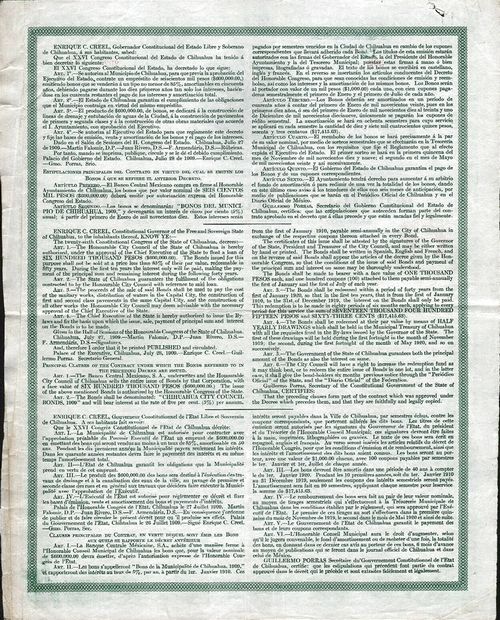
On 27 July 1909 the city was authorised to raise $600,000 through an issue of 600 $1,000 bonds, to improve the water supply and sewerage network and pave the main roads.On 30 August the American Bank Note Company in Mexico City asked its head offices for a price for 600 bonds, with 100 coupons, carrying a special vignette of the Chuvíscar Reservoir{footnote}ABNC{/footnote}. On 27 November José Asúnsolo, the jefe politico, placed the order{footnote}ABNC{/footnote}.
On 24 December the ABNC sent models of the bond and coupon for approval. As they had not heard whether their price for engraving the vignette of the reservoir had been accepted, they used a stock vignette of the Mexican eagle, which they thought made a very good looking bond and was the best vignette available, unless the municipio decided on the special vignette{footnote}ABNC, letter manager Foreign Sales{/footnote}. Asunsolo made a few corrections but accepted the vignette{footnote}ABNC letter José Asunsolo to ABNC, Mexico City, 10 January 1910{/footnote}. The bonds, in two books, were dispatched on 11 March{footnote}ABNC,letter 11 March 1910 to José Asúnsolo,Presidente Municipal of Chihuahua{/footnote}.
All were issued and none redeemed. On 22 February 1911 the Banco Central Mexicano sent 77 coupons (numbered between 3 and 481) to the Banco Minero to present to the ayuntamiento which were lost en route when the train was attacked and destroyed{footnote}AMC, Fondo Revolución, Sección Justicia, Año 1911, caja 1, exp. 5{/footnote}.
At the outbreak of the revolution the city had $33,000 of the first issue and $600,000 of the second outstanding.
On 29 October 1929 William J. McCafferty, the American Consul in Chihuahua, was instructed by the State Department, on behalf of Halsey, Stuart and Company of New York, to find out about these bonds and reported that the Chihuahua Treasurer General had told him that payments had been suspended because the State Legislature had not provided for the resumption of the service of the public debt of the State. The Treasurer General added that service would be resumed as soon as the economic condition of the Treasury permitted{footnote}SD papers, 812.51{/footnote}. On 7 March 1932 the Comité Liquidador de los Antiguos Bancos de Emisión sent a memorandum to its legal departments that Chihuahua municipal bonds had no actual value as they were not paying any interest{footnote}AGN, Comisión Monetaria/Antiguos Bancos de Emisión, caja 112{/footnote}.
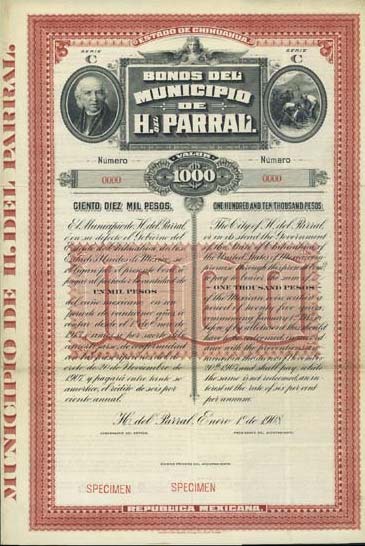
Between 1905 and 1907 the town council (ayuntamiento) of Hidalgo del Parral was authorised to issue three series of $1,000 bonds, paying 6% interest and amortizable over twenty-five years. The proceeds were to pay for the provision of water and drainage in the city.
The bonds were printed by the American Bank Note Company. They were signed by the Governor of the state and Presidente and Síndico Primero of the town council.
Series A, authorised on 23 October 1905 and dated 1 July 1906, was of $300,000. We have records of the following redemptions:
| Date | Numbers |
| 30 June 1909 | 7, 75, 93, 270 |
| 31 December 1907{footnote}Periódico Oficial, 9 January 1908{/footnote} | 140, 193, 283 |
| 30 June 1910 | 63, 205, 292 |
| 31 December 1910 | 81, 106, 160, 178 |
As of 22 March 1911 266 Series A bonds were outstanding{footnote}AMP, Tesorería, Tesorería, Ingresos y egresos, caja 213, exp 10{/footnote} and coupons were paid up to January 1913{footnote}AMP, Tesorería, Tesorería, Correspondencia, caja 164, exp. 1{/footnote}.
Series B was authorised 11 July 1907 and dated 15 September 1907. On 8 September Rodolfo Valles, the jefe político of Parral, ordered 200 bonds of this second issue from the American Bank Note Company. These were to be for $1,000 each, blue, Series B, numbered 1 to 200 and carry 59 coupons. They were to be signed by José María Sánchez, acting governor of Chihuahua, in place of Enrique C. Creel, and the Presidente and Sindico Primero of Parral{footnote}ABNC{/footnote}. The bonds were needed as soon as possible as George J. Ham, the President of the United States Banking Company, had bought the issue for his company and had the chance to make a quick turn over on the operation if the bonds were delivered in Parral by the middle of December{footnote}ABNC letter Hendriks, resident agent to ABNC, 21 September 1907{/footnote}. The ABNC sent proofs on 11 November and these were approved on 27 November{footnote}ABNC{/footnote}.
The 200 bonds of the second issue were dispatched on 10 January 1908{footnote}ABNC{/footnote}. Until the bonds were issued, holders were given provisional certificates (certificados provisionales) signed by the Presidente and Sindico Primero and these certificates were exchanged for the definitive bonds on 21 February 1908{footnote}Periódico Oficial, 12 March 1908{/footnote}.
The bonds carried interest of 6% and some were redeemed by six-monthly lotteries. We have records of the following redemptions:
| Date | Numbers |
| 31 December 1906 | 110, 136, 199, 229, 235, 276 |
| 1 July 1907 | 27, 88, 151, 171, 272, 281 |
| 31 December 1907 | 103, 125 |
| 30 June 1908 | 112, 271, 298 |
| 31 December 1908 | 168, 172, 250 |
Series C, authorised on 20 November 1907 and dated 1 January 1908, was for $110,000.
On 3 December 1907, Valles ordered this third series, of 110 bonds, numbered 1 to 110, with 60 coupons, this time printed in red. Again the matter was urgent, as Valles wanted to place them on the market as soon as possible. Proofs were sent on 13 February 1908 and approved (with a minor alteration) on 21 February{footnote}ABNC{/footnote}.